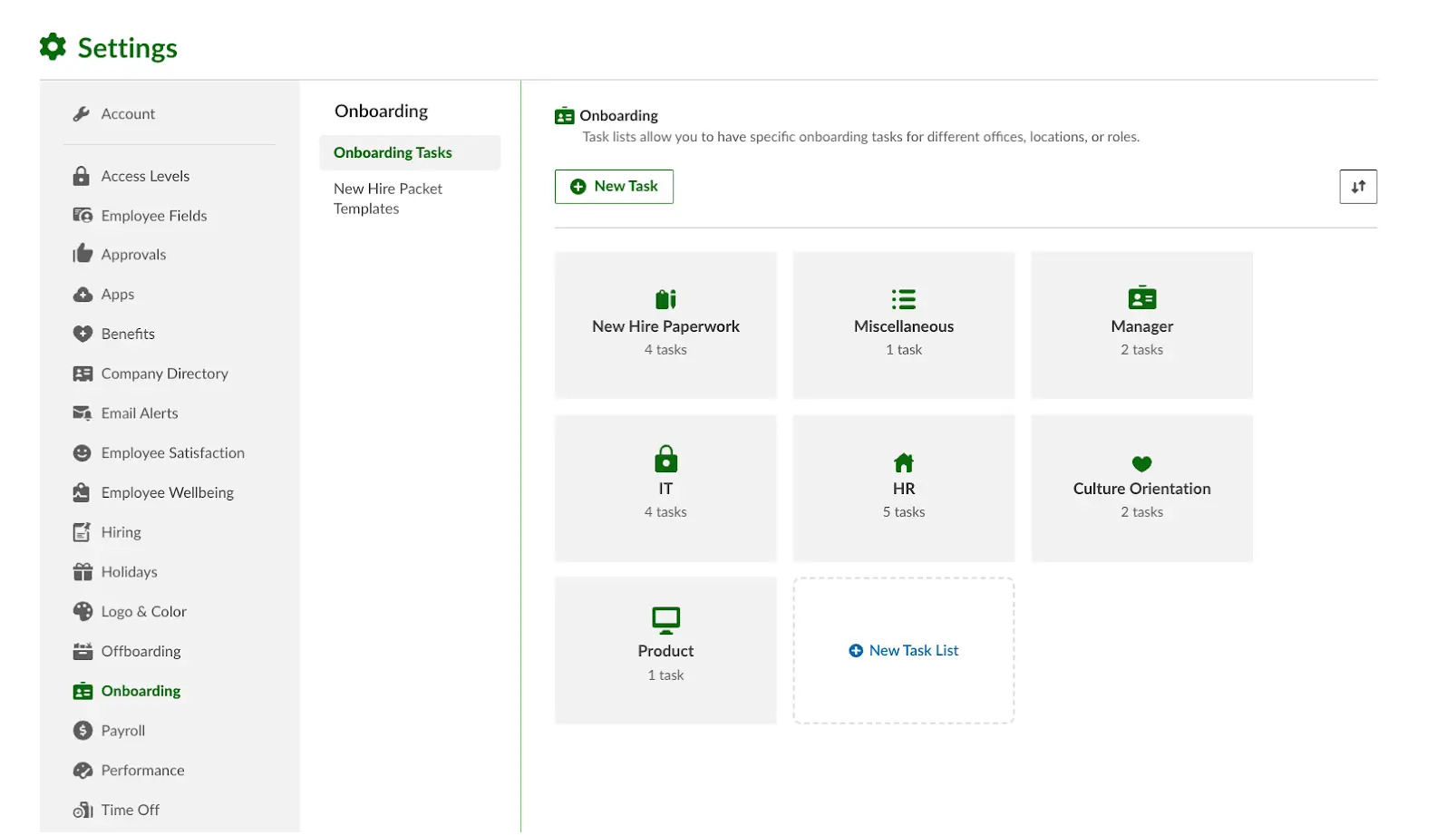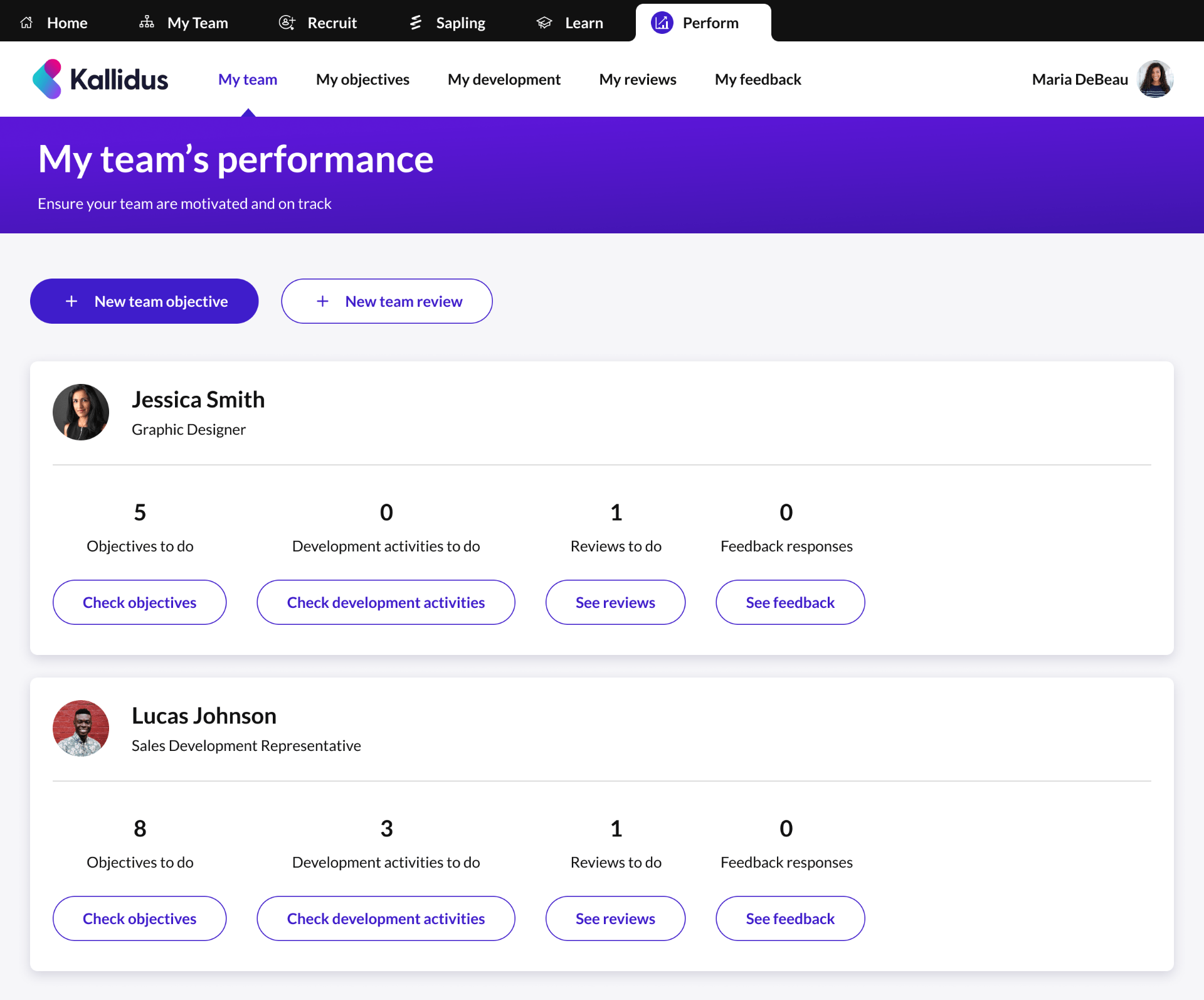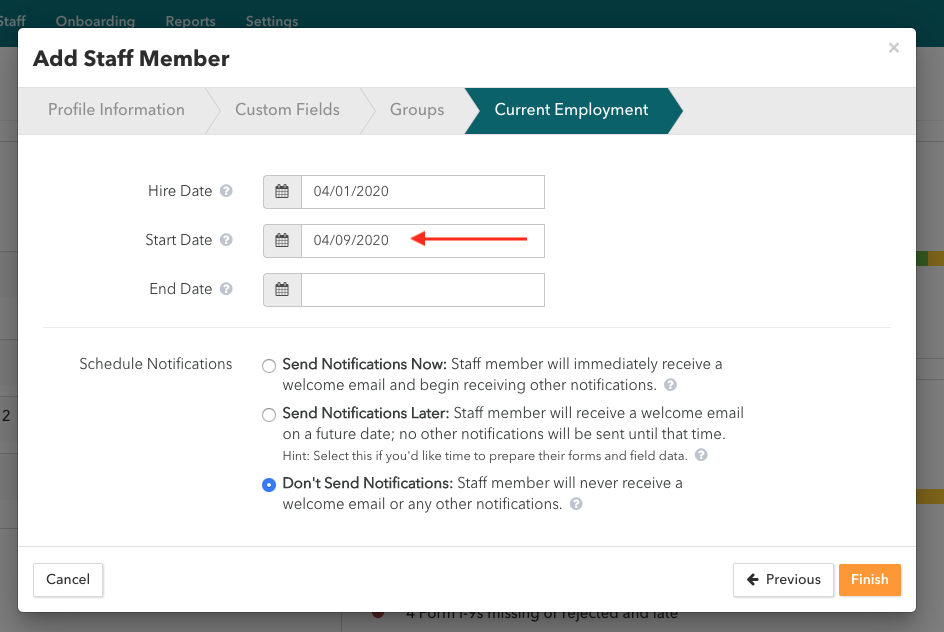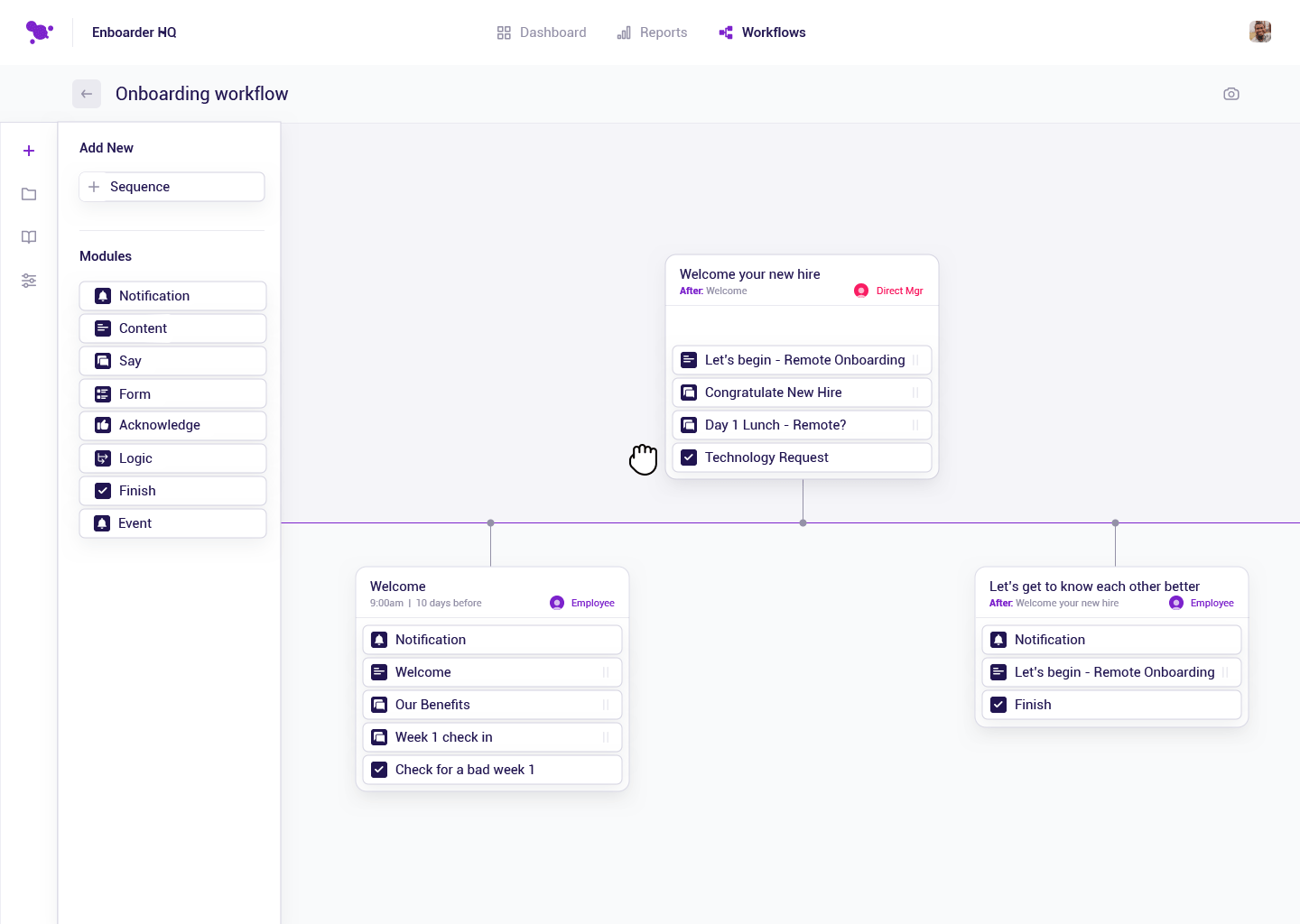Welcoming new hires virtually is not new. But replacing handshakes with video calls still leaves many organizations wondering whether virtual onboarding can truly be successful and sustainable.
Absolutely!
This guide will show you how to navigate the virtual onboarding process, eliminate the stress of integrating new team members, and ensure they feel engaged from day one.
Continue reading to find out.
What Is Virtual Onboarding?
Virtual onboarding is the process of welcoming and integrating new employees into a company entirely through digital tools and technology. This type of onboarding is often used when the new hires will be working remotely.
It’s essentially a remote version of the traditional in-person onboarding where new hires are shown the ropes at a physical office.
Virtual onboarding is becoming increasingly common as more and more companies have remote or hybrid workforces. Recruits are introduced to the company culture, mission, and their role through video meetings, online training modules, and a virtual workspace setup.
Virtual onboarding can be efficient for both employers and employees, and it can also be a good way to create a welcoming and inclusive experience for new hires regardless of location.
Why Virtual Onboarding Is Vital in a Remote Work Environment?
Without a solid virtual onboarding process, your new hires’ experience can quickly become a whirlwind of confusion and frustration.
Here’s why virtual onboarding matters in a remote work setup:
- Remote Boot Camp: It equips your incoming employees with the knowledge and tools to navigate your new company virtually. Think of it as a crash course in learning about their roles, what your organization does, key members, and so on.
- Building Bridges, Not Walls: Remote work can feel isolating, but virtual onboarding through remote IT software helps you forge connections with your new members, even if they’re thousands of miles away. It’s like a virtual team-building exercise.
- Culture Club: Company culture is more than just a ping-pong table in the break room (although that can be pretty sweet, too). Virtual onboarding immerses recruits in the company’s values and personality and makes them feel like valued members of the team from day one.
- Bossing Your Own Pace: No more information overload! Depending on the onboarding plan, modules, and platform used, virtual onboarding lets new hires learn at their own speed, whether they’re speed demons or prefer to savor the knowledge.
In short, virtual onboarding is like having a personal assistant guiding you through the wonders of your new remote job.
What Are the Benefits of Virtual Onboarding?
Virtual onboarding offers advantages for both employers and new hires. Let’s see how:
For Employers:
- Increased Efficiency: Virtual onboarding streamlines the process using digital tools like online forms and pre-recorded training modules. This saves time and reduces administrative burdens on HR and managers.
- Cost-Effective: Virtual onboarding eliminates expenses associated with traditional onboarding, such as venue rentals, catering, and travel costs for geographically dispersed hires.
- Scalability: Virtual onboarding programs can be easily scaled to accommodate any number of new hires, especially if you use a cloud learning management system (LMS), such as ProProfs Training Maker.
- Improved Data Tracking: Virtual onboarding platforms allow employers to track employee progress through training modules and identify areas where additional support may be needed.
- Wider Talent Pool: Virtual onboarding enables employers to hire top talent regardless of location. This opens up a wider pool of qualified candidates.
For New Hires:
- Flexibility and Convenience: New hires can access training materials and complete tasks at their own pace and convenience. This reduces the stress and anxiety usually associated with starting a new job.
- Personalized Learning: Virtual onboarding programs can be tailored to individual learning styles to allow new hires to focus on the information most relevant to their role.
- Consistency: With virtual onboarding, everyone gets access to the same information the same way, regardless of location or who’s training them. This ensures everyone starts with the same foundation of understanding a company and their job role.
- Reduced Onboarding Time: Virtual onboarding can get new hires up to speed faster by eliminating the need for travel and lengthy in-person sessions.
- Improved Knowledge Retention: On-demand access to training materials allows new hires to revisit information as needed, and this drastically improves knowledge retention.
Real-Life Success Story
In-Person vs. Virtual Onboarding: Which Is Better for Your Team?
Both in-person and virtual onboarding have their strengths, but for today’s workforce, virtual onboarding offers a compelling package. Here’s how they compare:
In-Person vs. Virtual Onboarding
| Feature | In-Person Onboarding | Virtual Onboarding |
|---|---|---|
| Company Culture | Builds a strong sense of belonging | Limited ability to build a culture |
| Learning Style | Excellent for hands-on roles | May require adaptation for hands-on roles |
| Flexibility | Less flexible, requires physical presence | Highly flexible, location-independent |
| Scalability | Less scalable, logistically complex for large groups | Highly scalable, easily accommodates growth |
| Cost-effectiveness | Higher costs due to travel and venue | Lower costs, no travel or venue expenses |
| Consistency | Consistency may vary depending on the facilitator | Consistent information delivery for all |
| Accessibility | Limited to those who can be physically present | Accessible to geographically dispersed teams |
The virtual edge: Technology offers creative solutions to bridge the physical gap. Interactive platforms, social activities, and video calls can foster connection and engagement.
The takeaway: While in-person interaction holds value, virtual onboarding provides a strong foundation with greater reach, adaptability, and cost-effectiveness. All this makes it a powerful tool for building successful teams in a dynamic work environment.
Bonus point: Virtual onboarding can be blended easily with occasional in-person elements for a hybrid approach, and you can leverage the strengths of both methods.
Get Free Employee Training Software — All Features, Forever.
We've helped 567 companies train 200,000+ employees. Create courses in under a minute with our AI LMS or use 200+ ready-made courses on compliance, harassment, DEI, onboarding, and more!
What Are the Common Challenges of Virtual Onboarding and How to Overcome Them?
Virtual onboarding, while increasingly common, comes with its own set of hurdles. Here are some of the most frequently encountered challenges and virtual onboarding best practices to address them:
Lack of In-Person Interaction
Building relationships and company culture can be difficult without face-to-face interactions. New hires might feel isolated.
Solution: Schedule virtual coffee chats, team lunches (using food delivery services), or online team-building activities. Encourage video calls over emails for communication.
Tech Troubles
Remote employees setting up equipment and software on their own can lead to delays and frustration.
Solution: Provide clear instructions and IT support resources beforehand. Consider pre-configuring work laptops or offering a stipend for home office equipment.
Information Overload
New hires might be bombarded with digital materials and learning modules, leading to confusion and disengagement.
Solution: Break down information into manageable chunks. Use a mix of formats like videos, presentations, and interactive modules. Consider spaced repetition to reinforce key points.
Unclear Communication Expectations
With various communication tools (email, messaging, video calls), new hires might be unsure of which platform to use for what purpose.
Solution: Establish clear communication guidelines. Specify preferred channels for different types of communication (urgent messages vs. casual updates).
Limited Mentorship & Support
Remote new hires might miss out on informal learning opportunities that happen through casual interactions with colleagues in a physical office.
Solution: Assign a virtual onboarding buddy, a senior colleague who can answer questions, provide guidance, and offer support.
By addressing these challenges, companies can create a smooth and engaging virtual onboarding experience that helps new hires feel welcome, informed, and empowered to succeed in their roles.
Steps for Effective Virtual Onboarding Process
Wondering how to conduct virtual onboarding? Here are the standard and proven steps to ensure a successful virtual onboarding process:
Step 1. Pre-Onboarding Preparation
- Send Welcome Packet: Provide a digital welcome packet including an introduction to the company culture, values, mission, and vision.
- Tech Setup: Ensure all necessary technology and equipment (laptop, software, login credentials) are sent to the new hire in advance.
- Onboarding Schedule: Share a detailed onboarding schedule outlining the agenda for the first week or month.
Step 2. First Day Welcome
- Welcome Email: Send a personalized welcome email with links to important resources and contact information.
- Virtual Office Tour: Conduct a virtual tour of the office, introducing key team members and departments.
- HR Meeting: Schedule a meeting with HR to discuss benefits, company policies, and procedures.
Step 3. Orientation and Training
- Company Overview Session: Conduct a session to provide an overview of the company’s history, goals, and organizational structure.
- Role-Specific Training: Offer comprehensive training specific to the new hire’s role, including tools, processes, and expectations.
- Compliance Training: Ensure completion of mandatory compliance and safety training.
Step 4. Engagement and Integration
- Mentorship Program: Assign a mentor or buddy to help the new hire acclimate and answer any questions.
- Team Introductions: Schedule virtual meet-and-greet sessions with team members and key stakeholders.
- Interactive Sessions: Include interactive sessions such as Q&A, brainstorming, and team-building activities.
Step 5. Regular Check-ins and Feedback
- Weekly Check-ins: Schedule regular check-ins with the manager and HR to address any concerns and track progress.
- Feedback Loop: Create opportunities for new hires to provide feedback on the onboarding process to make continuous improvements.
- Progress Reviews: Conduct periodic reviews to discuss performance, goals, and development plans.
Step 6. Resources and Support
- Resource Hub: Provide access to a centralized digital resource hub with training materials, FAQs, and company documentation.
- Support Channels: Ensure there are clear channels for technical and HR support, such as help desks or dedicated support teams.
Step 7. Social Integration
- Virtual Social Events: Organize virtual social events, like coffee chats or happy hours, to build camaraderie.
- Employee Resource Groups: Encourage participation in employee resource groups or clubs to foster a sense of community.
Step 8. Continuous Development
- Ongoing Training: Offer continuous learning opportunities and professional development programs.
- Career Pathing: Discuss potential career paths and growth opportunities within the organization.
Step 9. Evaluation and Improvement
- Onboarding Survey: Conduct surveys to gather feedback from new hires about their onboarding experience.
- Analyze and Improve: Regularly analyze feedback and make necessary adjustments to the onboarding process to enhance effectiveness.
By implementing these steps, you can ensure a structured and engaging virtual onboarding experience that helps new hires in multiple ways.
Top 5 Virtual Onboarding Software
I’ve compiled this tool list based on firsthand experience, user testimonials, reviews by neutral third-party sites, and recommendations from industry peers.
1. ProProfs Training Maker
ProProfs Training Maker streamlines virtual onboarding by automating the entire process and saving you time and resources.
You can create engaging online courses with text, videos, PDFs, and presentations, or upload your existing training materials. Design personalized learning paths and automatically assign courses based on participants’ roles. You can train them on policies, skills, safety, and compliance.
Similarly, tracking trainee progress and completion in real-time is easy. It ensures everyone is on the same page.
Plus, you can measure the effectiveness of your onboarding programs with detailed reports, which let you identify areas for improvement and onboard new hires faster for better overall productivity.
Key Features:
- A Massive Library of Courses & Templates: These resources, consisting of hundreds of expert-designed, ready-to-use, and editable premium online courses and templates, help onboard new hires rapidly in my organization.
- Quizzes for Assessment: I can measure learning outcomes with engaging quizzes. The video responses and the ability to prevent question skipping are other helpful features.
- English, Spanish & 70+ Other Languages: Easily onboard and train a global audience in their native languages. The LMS supports English, Spanish, and 70+ other languages.
- 100+ Customization Options: Configure the LMS to meet your specific needs. Set up custom settings for courses, learner groups, notifications, security, and branding.
- Multiple Instructors/Admins: I’ve seen how creating multiple roles for instructors and administrators could simplify large-scale onboarding and training.
- HRMS Integrations: Seamlessly integrate with HR management systems like BambooHR and TribeHR to track employee progress and streamline training workflows, ensuring smooth data synchronization across platforms.
Pricing:
Forever free for small teams. Paid plans start at $1.99/active learner/month. 15-day money-back guarantee. No hidden charges.
2. BambooHR

BambooHR tackles the challenges of virtual onboarding head-on by providing a suite of features. These features are designed to create a welcoming and informative experience for new hires, even when they’re remote.
The platform supports pre-boarding tasks like electronic paperwork completion and “Get to Know You” questionnaires to foster connection before the first day.
BambooHR also facilitates introductions with customizable welcome packets and automated emails to help new team members build relationships despite the physical distance. This, combined with streamlined checklists and efficient document management, frees up valuable time for virtual training sessions and fosters a sense of belonging in the company culture.
By focusing on the practical and social aspects of onboarding, BambooHR helps remote employees feel prepared, connected, and excited to contribute from day one.
Key Features:
- Centralized Employee Database: Securely store all employee information in one place, accessible to authorized personnel.
- Automated Workflows: Streamline HR processes with automated workflows for tasks like time-off approvals and onboarding steps.
- Applicant Tracking System (ATS): Manage the entire hiring process, from attracting candidates to scheduling interviews.
- Time Off & Benefits Tracking: Empower employees to request and track time off, and manage benefits enrollment directly in the system.
- Reporting & Analytics: Gain valuable insights into your workforce with pre-built reports and data analysis tools.
Pricing:
Custom quote.
3. Kallidus

Kallidus makes onboarding a breeze for HR and new hires. By automating tasks and workflows, it eliminates repetitive manual work like filling out forms and assigning training modules. This frees up HR’s time and allows new hires to focus on acclimating to the company culture and role.
Kallidus also offers pre-boarding features that welcome new hires before their start date and set a positive tone for their experience.
Additionally, Kallidus ensures a smooth offboarding process. With the software, you can automate the collection of equipment and access revocations, save time, and minimize security risks.
The platform facilitates a positive exit experience by gathering feedback from departing employees to gain valuable insights to improve your workplace.
Key Features:
- Automated Workflows: Streamline onboarding by automating how you send welcome emails, assign training materials, and collect new hire information.
- Centralized Document Management: Store and manage all onboarding documents (forms, contracts, etc.) in one secure location.
- Pre-Boarding Features: Engage new hires before their start date with company information, cultural resources, and to-do lists.
- Progress Tracking: Monitor new hire onboarding progress in real-time and ensure they complete all required tasks and activities.
- Social Onboarding: Facilitate connections between new hires and colleagues through mentorship programs and social activities.
Pricing:
Custom quote.
4. WorkBright

Fast-tracking virtual onboarding can be tricky, but WorkBright helps. This onboarding software is designed with remote hires in mind. It boasts a mobile-first design and allows new hires to complete tasks like complex forms from their phone. No more waiting for physical paperwork to be mailed in!
WorkBright also automates reminders and workflows to keep things moving smoothly. By streamlining paperwork and eliminating administrative burdens, WorkBright cuts down onboarding time.
With WorkBright, you can ditch the slow lane and get your virtual team members on the fast track to success. It utilizes smart features like auto-fill for repetitive fields and error-checking to accelerate the process further. This translates to a smoother onboarding experience and reduces stress and anxiety often associated with starting a new job remotely.
With WorkBright, you can get your virtual team members acclimated, equipped, and contributing faster.
Key Features:
- Mobile-First Design: New hires can complete onboarding tasks from their smartphones or tablets, including complex forms.
- Automated Reminders & Workflows: WorkBright keeps the process moving with automated nudges and predefined task sequences.
- Smart I-9 With Geolocation: This streamlines the completion of the I-9 form for remote hires while ensuring compliance.
- Error-Checking & Auto-Fill: WorkBright reduces errors and saves time with features like auto-fill for repetitive fields and real-time error detection.
- Secure Document Storage: The tool protects sensitive data with bank-grade encryption.
Pricing:
Custom quote.
5. Enboarder

Enboarder is a virtual onboarding software designed to create a smooth and engaging experience for new hires, especially those joining remotely.
It helps companies automate tasks, personalize the onboarding journey, and facilitate connections between new hires and their colleagues, information, and company culture. In other words, it ensures a frictionless onboarding process.
The software enables companies to create customized onboarding experiences based on the role, department, or location of the new hires.
Unlike traditional onboarding software that focuses solely on paperwork, Enboarder emphasizes building human connections. It provides features for virtual introductions, mentoring programs, and fostering communication.
Enboarder recognizes that feeling connected is crucial for employee well-being, engagement, and retention. Their approach aims to bridge the gap created by physical distance in remote or hybrid work environments.
Key Features:
- Seamless Experience: No logins or downloads required for new hires, accessible through various channels like SMS or messaging apps.
- Best-Practice Templates: Leverage pre-built onboarding programs and templates designed based on industry best practices.
- Multilingual Support: Cater to a global workforce by offering onboarding experiences in multiple languages.
- Self-Service Portal: Empower new hires to access information and complete tasks independently through a self-service portal.
- Performance Benchmarking: Compare your onboarding program’s effectiveness against industry benchmarks and identify areas for improvement.
Pricing:
$9,950.00/year
Take the First Step Today to Capitalize on Virtual Onboarding!
By embracing virtual onboarding, you can unlock a powerful system for integrating remote talent seamlessly. Its adaptability and cost-effectiveness make it a winner in today’s evolving work landscape.
With a well-structured process, from pre-boarding to ongoing engagement, and the right software to support it, you can empower your new hires to thrive.
So, take the first step to refine your virtual onboarding programs and watch your remote teams flourish.
Get Free Employee Training Software — All Features, Forever.
We've helped 567 companies train 200,000+ employees. Create courses in under a minute with our AI LMS or use 200+ ready-made courses on compliance, harassment, DEI, onboarding, and more!
Frequently Asked Questions
What are some common virtual onboarding examples?
Common virtual onboarding examples include virtual orientations through live or recorded video sessions; interactive training modules with online courses and quizzes; virtual meet-and-greets via video calls; mentorship programs pairing new employees with experienced mentors; digital paperwork for completing necessary HR forms; and onboarding portals that serve as centralized digital hubs containing resources, company information, and learning materials. How to Create an Online Course in Under 5 Mins (With Ravi Roy)
How do companies use technology for virtual onboarding?
Companies do so by utilizing video conferencing tools like Zoom, Microsoft Teams, or Google Meet for orientations, training sessions, and meetings; an LMS such as Moodle or ProProfs Training Maker to deliver and track training programs; HR software like BambooHR or Workday for managing digital paperwork and employee records; virtual reality (VR) experiences to simulate real-world training scenarios; and project management tools such as Trello, Asana, or Monday.com to help new hires understand and manage their tasks and projects. Watch: How to Integrate BambooHR With ProProfs LMS to Automate New Employee
What are the key components of the best virtual onboarding experience?
Clear communication of company culture and values, comprehensive and engaging training programs, seamless integration of technology for an interactive experience, and opportunities for new hires to build relationships through virtual meet-and-greets and team-building activities. Ongoing support through mentorship programs and easy access to necessary resources and information via centralized digital hubs or onboarding portals are other elements.
How do I make virtual onboarding fun?
Incorporate interactive and engaging elements, such as gamified training modules, virtual icebreakers, and team-building activities. Using video conferencing tools for casual meet-and-greet sessions, offering virtual tours of the company, and organizing online social events like trivia games or virtual happy hours can also help. Additionally, personalized welcome packages and creative onboarding challenges can make the process more enjoyable and memorable for new hires. Read: How to Configure the ProProfs Training Maker Gamification Features
 Tips
Tips
We’d love to hear your tips & suggestions on this article!
Get Free Employee Training Software — All Features, Forever.
We've helped 567 companies train 200,000+ employees. Create courses in under a minute with our AI LMS or use 200+ ready-made courses on compliance, harassment, DEI, onboarding, and more!

 We'd love your feedback!
We'd love your feedback! Thanks for your feedback!
Thanks for your feedback!







